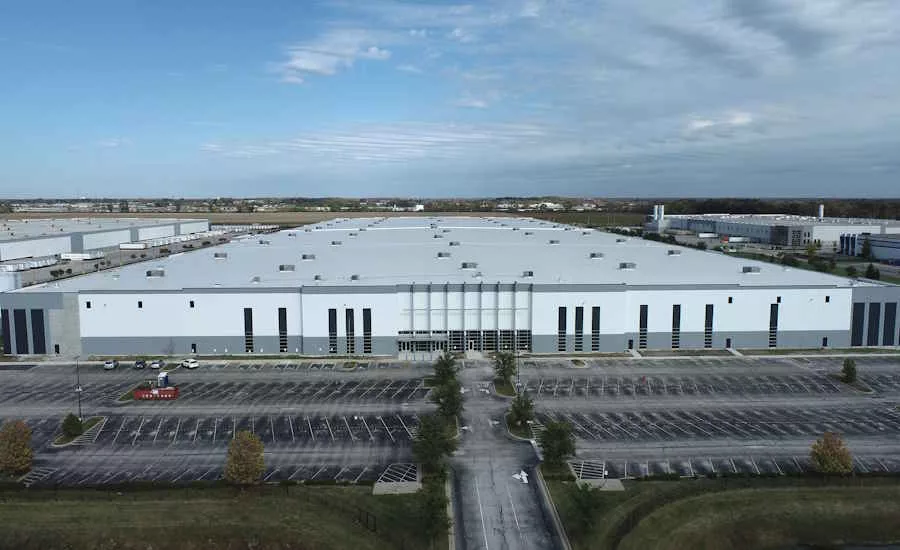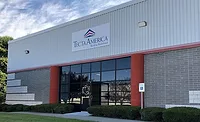Sponsored by Johns Manville
How CE REEVE Roofing Flourished, Joining Tecta America
Partners at a start-up commercial roofing firm received what would be considered a ‘once-in-a-lifetime’ opportunity; the ‘unicorn’ of offers followed a decade later

AllPoints at Anson is a 616-acre office park designed to accommodate more than 7 million square feet of distribution, build-to-suit, data centers and advanced manufacturing facilities. CE REEVE was the contractor for “AllPoints 3,” which has a roof encompassing nearly 1.5 million square feet, completed using Johns Manville’s 060 TPO RhinoPlate Roof System. Photo courtesy of CE REEVE Roofing, a Tecta America Company LLC.
Finding humor in a one-off similarity has a way of morphing into a through line, as it did for the two men who turned a once-small roofing company into a $60 million annual sales juggernaut.
For Bryan Klepinger and Stacy Agnew, the president and the director of business development for C.E. REEVE Roofing, a Tecta America company, respectively, the unique element of commonality involves their forenames, eliciting a good laugh all around.
When asked what it was like for Klepinger growing up in the 1970s with his given name spelled in a once avant-garde use of the letter ‘y’ (instead of the more traditional ‘i’), he easily recalled challenges finding anything personalized with his name spelled accurately.
“Oh yeah, a mug or a keychain, that was tough,” he said, laughing; Agnew then offered his blunt paean of struggle: “I’ve got a girl’s name!”
And, in a nutshell, that hint of snark is a snapshot encapsulating the good-natured disposition and collegial relationship the two men helming the commercial roofing contracting firm, based in Indianapolis, enjoy.
Their 80-some-odd years of combined experience in commercial roof system installation has helped establish CE REEVE as a principal go-to commercial roofing contractor for clients throughout Indiana and several other states.
Klepinger, 54 and Agnew, 57, both Indiana natives, share similar origin stories insofar as how each came to roofing before meeting the other, eventually collaborating in a start-up that subsequently led them to acquire CE REEVE and then become members of America’s largest commercial roofing enterprise, Tecta America, is another complement.
It’s worth reflecting on where their careers currently reside: principal members of Tecta America, based in the Chicago suburb of Rosemont, Ill., which was founded in 2000 when commercial roofing went through its version of today’s residential contractor consolidation.
The company established itself through the convergence of 10 separate roofing firms under a singular umbrella organization that now boasts more than 70 locations nationwide. Tecta sits in pole position with both Roofing Contractor and its sister publication, Engineering Record-News, for 2023’s top roofing firms, having overtaken commercial roofing’s long-time bellwether, CentiMark, which lounged at No. 1 on RC’s Top 100 list of firms as recently as 2022 and for several years prior.
Today, Tecta America is unarguably the largest commercial roofing firm in the United States, and according to RC’s 2023 Top 100, the company generates revenue in excess of $1 billion annually. It’s a remarkable achievement and one that CE Reeve helps play a role in making possible.
“Business is gangbusters right now,” Dave Reginelli, president and CEO of Tecta America, told RC for its annual Commercial Roofing Report, included in December 2023’s eMagazine.
But before Tecta or even CE REEVE, there was the ascent Agnew and Klepinger each undertook — laboring, learning, stumbling and succeeding, which ultimately led them to the perches each now enjoys on the top rung among their peers within commercial roofing.
The ‘Y’ Intersection
Agnew, the ostensible elder statesman of the two, grew up in the suburbs of Indianapolis; Klepinger was raised in a small town in Northern Indiana. Each man started on the traditional path of graduating from high school and heading off to college. And, like the oddities of their given names, each man recognized that a road less traveled could actually become a more direct path toward happiness and success.
Agnew had family, including a brother and stepbrother, who worked in commercial roofing, which gave him entrée into the industry the summer before his senior year of high school. Working at the same company as his siblings, Agnew started where most do: in the yard. He found himself cleaning kettles and equipment.
After graduation, he did what was expected of him and enrolled in college. The summer after his first year, he went back to the same company he worked for previously and, ultimately, decided he didn’t have to go to college after all.
“I started working full time as a laborer with my brothers on their crews and gradually went from a labor to a foreman to a project manager to an estimator,” Agnew recalled. “Eventually, [I became] a part owner of that company.”
As a jumping point, Agnew eventually sold his interest in that firm and, in 2001, founded a new commercial roofing outfit called Commercial Roofing Services.
“I [again] started from the ground, as low as you could go, and eventually worked up to where we’re at today,” he explained.
Klepinger’s decision to go into commercial roofing was more textbook insofar as he pursued a degree in building construction technology in college. As part of that major’s requirements, he explained, he had to find an internship in the construction industry. Having a friend who worked for a commercial roofing company, Klepinger said the deal was sweetened by the fact his buddy also had an extra room where he could live.
“So I was like, ‘Man, let’s do it; it’s, you know, it’s a couple months during the summer,’” Klepinger said. “And again, kind of similar story to Stacy’s [background], certain circumstances, I didn’t end up going back and finishing college. So I stayed on there and thought, ‘Well, work another year, save up some money, and I’ll go back.’”
Before Klepinger knew it, the year had come and gone, and during that year, he had been promoted to a foreman and given his own truck, and, as he said, “the rest is just kind of history.”
Their convergence happened in 2003 when Agnew started to build CRS with another partner and was looking for someone to head up operations. Klepinger, who was running operations for a separate roofing outfit at that point, recognized something that drew him to leave his position and join CRS, securing an interest in the firm and making him CRS’ third principal.
As CRS grew in size, gaining work principally on low-slope industrial projects like warehouses, its stature and reputation for excellence grew in tandem. Agnew, having the experience of starting the firm, remained in charge but was also forward-facing, envisioning what “could be” with Klepinger in the mix.
Becoming CE REEVE, a Tecta America Company
CE REEVE Roofing was founded in 1936 by Clarence Reeve. Through the post-war years, the company prospered as a commercial roofing firm in the Indianapolis market and was eventually handed down to Clarence’s grandson, Ed, and a nephew, Agnew explained. The third-generation Reeves took to the wheelhouse sometime in the late 1960s or early 1970s.
Enter another pair of Reeve family members, Jim Reeve and Don Reeve; Agnew said they assumed management of the firm and, by all yardsticks, were successful over the next 40-some-odd years.
Then, something unique in the annals of mergers and acquisitions occurred in 2006: Ed Reeve approached CRS, a smaller firm revenue-wise, to see whether there was any interest from Agnew and Klepinger to acquire his family’s company.
The answer is self-evident, and in 2007, Agnew and Klepinger took ownership of CE REEVE; Agnew said Ed Reeve stayed on through the transition. Agnew assumed the role of president and, with his partner by his side, leveraged the firm’s established reputation to increase revenue and expand its footprint to states including Kentucky, Ohio, Illinois, and as far as Arizona.
The pivot from start-up to running an established brand was a good fit for the two. Having a firm with brand-name recognition combined with the attention to detail the principals espouse has been the secret to the firm’s success. Agnew estimates that from the time of acquisition to date, revenue has grown by more than 400%.
Of course, when you’re a big fish in a small pond, attracting attention is inevitable, which, in this case, was an apex firm looking to expand its reach nationwide. In 2017, Tecta America made an entreaty to CE REEVE, selling the principals on joining a family of commercial roofing companies with a reach extending from California to New England.
“It was a decade to the day,” Agnew said about the explosive growth the company has enjoyed under the Tecta portfolio. “We went from about $12 million in sales to over $60 million-plus.”
From ‘Ma & Pop’ to Corporate
Given the significant resources availed to CE REEVE after becoming part of Tecta, both principals have no qualms. In 2019, Tecta announced that Agnew ceded the wheelhouse to Klepinger, which circles back to the halcyon days of their start-up when Agnew foresaw the need for a successor one day.
Delineating the advantages of unbounded resources, collaboration with other top-tier commercial outfits and the professional best practices Tecta brought to the table, Agnew and Klepinger neither have regrets nor doubts the move was in everyone’s best interest.
“It’s always different when you own the company versus when you work for somebody else that owns the company,” Klepinger acknowledged. “When you’re making decisions on a day-to-day basis when you own the company, you can make decisions one way, but when it’s somebody else’s business and you’re making those decisions, you’ve got to think of how it’s going to affect [the big picture.]”
Yet, any seeming loss of autonomy is undoubtedly made up by the tremendous growth spurt the company has enjoyed. One of the more distinctive aspects of the acquisition was a caveat that was promised by Agnew and Klepinger to Ed Reeve back in the early 2000s: No changing the name. Hence, after the acquisition closed, the newly christened CE REEVE, a Tecta America Company, became one of Tecta’s few companies that retained its original name ahead of the umbrella brand.
“That the business is a ‘whole’ rather than just our one operation here [was] probably the biggest change for us, just getting used to that,” Agnew added. “But there’s been many positives that came out of it as well, like technology, collaboration with other offices; it’s kind of unique that we can bounce ideas off other people.”
In terms of the company’s core competencies, CE REEVE sticks with what works, which are large-scale, low-slope buildings, both industrial and commercial, that may not have intricate roof systems but the lack of “bling” is compensated by scale.
The company has always employed best practices when it comes to safety, Klepinger said. Still, when you are working on a commercial or industrial building with upwards of 200,000 square feet, there are eyes on you at every turn. CE REEVE has a full-time safety superintendent whose job is to visit each site once or twice weekly to make sure safety protocols are followed.
When it comes to collaboration to achieve on-time delivery, the men extend their plaudits firstly to their principal supplier, Johns Manville. Klepinger said the firm’s relationship with JM is critical to ensure the materials needed to complete the job are always at the ready, and the company’s sales and training capacity has made their relationship indispensable.
“We really work with all the major manufacturers, including Elevate and Carlisle, but Johns Manville has been very important to us, especially during the whole material shortage issue; they helped us out on several projects,” Klepinger said.
“And, you know, I think we’re probably one of a few contractors that probably hit most of their higher programs, just from the volume that we do,” Agnew added, noting the incentive programs that many manufacturers and distributors roll out to their more significant customers.
Lest the role distributors play in CE REEVE’s efficiency and the added value provided gets lost in the shuffle, Klepinger concluded with this: “We primarily go through distribution for our [procurement] because, if we get into a pinch schedule-wise, we can reach out to them and ask for their assistance to help us unload those trucks and provide a crane if needed.”
And that was just one of the benefits each noted, exuding appreciation for all the disparate fingerprints that go into making their firm hum. The men doffed their caps to their primary distributor, Louis Ollesheimer & Son, an SRS Distribution company, alluding to the value distributors offer contractors.
“We don’t have [a] big warehouse here to store a bunch of extra leftover material, so by going through distribution if we have leftover material, we can take that back, and we don’t have to worry about storing and moving it all the time,” Klepinger said.
Looking for a reprint of this article?
From high-res PDFs to custom plaques, order your copy today!







